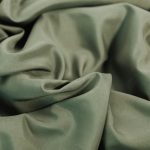Are you curious about the stretchiness of scuba crepe fabric? Look no further! In this article, we’ll explore what scuba crepe fabric is made of and delve into the factors that affect its stretchiness.
You’ll also learn how to test the stretchiness of this fabric and discover some valuable tips for working with it.
So, if you’re ready to dive into the world of scuba crepe fabric, let’s get started!
Table of Contents
What Is Scuba Crepe Fabric?
Scuba crepe fabric is a material that you’ll love because it provides both the stretchiness of scuba fabric and the textured look of crepe fabric. This unique blend of features makes it a popular choice for various clothing items and accessories.
The advantages of scuba crepe fabric are numerous. Firstly, its stretchiness allows for a comfortable fit and ease of movement. Whether you’re wearing a dress, a skirt, or pants made from scuba crepe fabric, you’ll find that it conforms to your body shape and enhances your silhouette.
Additionally, the textured look of crepe fabric adds a touch of elegance and sophistication to any outfit. The fabric drapes beautifully and creates a flattering effect.
However, it’s important to note that scuba crepe fabric does have some disadvantages. While it offers stretch, it may not be as stretchy as pure scuba fabric. This means that it may not have as much give as you might expect.
Additionally, scuba crepe fabric can be prone to wrinkling, so it may require some extra care when it comes to storage and maintenance.
Overall, scuba crepe fabric is a versatile and stylish option that combines the best of both worlds.
Understanding the Composition of Scuba Crepe Fabric
Scuba crepe fabric is known for its stretchiness, making it a popular choice for garments that require movement and flexibility.
Understanding the composition breakdown of scuba crepe is crucial in determining its stretchiness. By examining its blend of polyester and spandex, you can get a better idea of how much stretch the fabric will provide and how it will drape on the body.
Stretchiness of Scuba Crepe
To determine if scuba crepe fabric is stretchy, you can easily test it by pulling on the fabric and observing its elasticity. Scuba crepe fabric is known for its stretchiness, which makes it a popular choice for garments that require flexibility and comfort. The fabric properties of scuba crepe include a combination of polyester and spandex, which gives it the ability to stretch and recover its shape. The table below summarizes the key fabric properties of scuba crepe:
| Property | Description |
|---|---|
| Stretch | High |
| Recovery | Excellent |
| Durability | Good |
| Breathability | Moderate |
As you can see, scuba crepe fabric has a high stretchability and excellent recovery, meaning it can stretch comfortably without losing its original shape. Its durability and moderate breathability make it suitable for a variety of clothing items, from dresses to activewear.
Composition Breakdown of Scuba
If you’re curious about the composition breakdown of this material, scuba crepe is made from a combination of polyester and spandex. Scuba crepe fabric has several properties that make it a popular choice for clothing and accessories.
Here are some advantages of using scuba crepe fabric:
-
Stretchability: The spandex content in scuba crepe allows it to have a good amount of stretch. This makes it comfortable to wear and provides ease of movement.
-
Wrinkle resistance: Scuba crepe is known for its ability to resist wrinkles, making it a low-maintenance fabric. This makes it ideal for travel or everyday wear.
-
Structure and body: The polyester component of scuba crepe gives it structure and body, making it hold its shape well. This property is especially desirable for garments that require a more structured silhouette.
Factors Affecting the Stretchiness of Scuba Crepe Fabric
You’ll want to consider several factors when it comes to the stretchiness of scuba crepe fabric.
The first factor is the composition of the fabric itself. Scuba crepe is usually made from a combination of polyester and spandex, which gives it a good amount of stretch. The higher the percentage of spandex in the fabric, the more stretchy it will be.
Another factor to consider is the weight of the fabric. Generally, lighter weight scuba crepe fabrics tend to be more stretchy than heavier ones.
Additionally, the way the fabric is woven can also affect its stretchiness. Fabrics that are tightly woven tend to have less stretch, while looser weaves allow for more stretch.
When working with stretch fabrics like scuba crepe, there are a few tips to keep in mind.
First, it’s important to use the right sewing techniques. Using a stretch needle and a stretch stitch, such as a zigzag stitch or a straight stitch with a longer stitch length, can help prevent the fabric from puckering or breaking.
It’s also a good idea to use a walking foot or a stretch presser foot to ensure even feeding of the fabric.
Lastly, remember to prewash and dry the fabric before cutting and sewing to minimize any potential shrinkage.
How to Test the Stretchiness of Scuba Crepe Fabric
Testing the stretchiness of scuba crepe fabric can be done by gently pulling the fabric in different directions. Here are four steps to help you determine the elasticity of scuba crepe fabric:
-
Start by taking a small section of the fabric, about 2-3 inches wide.
-
Hold one end of the fabric firmly in one hand and the other end in the other hand.
-
Slowly and gently pull the fabric in one direction, applying a steady and even force.
-
Observe how much the fabric stretches. If it stretches easily and returns to its original shape, it is considered to be highly elastic. If it stretches a little or does not bounce back, it has low elasticity.
By following these steps, you can get a good idea of the stretchiness of scuba crepe fabric.
Keep in mind that different fabrics may have different levels of stretchiness, so it’s always a good idea to test a small section before using it for a project.
Tips for Working With Scuba Crepe Fabric
When working with scuba crepe fabric, it’s important to handle it with care to avoid any unwanted stretching or damage. Here are some tips for sewing scuba crepe fabric and recommended patterns to help you achieve the best results.
First, it’s crucial to use the right sewing machine needle. Opt for a ballpoint or stretch needle, as they are designed to prevent snagging and minimize damage to the fabric.
Next, make sure to use sharp fabric scissors when cutting scuba crepe fabric. This will ensure clean and precise cuts, preventing any fraying or unraveling.
When sewing, use a stretch stitch or a narrow zigzag stitch to allow the fabric to maintain its stretchiness. Avoid using a straight stitch, as it can cause the fabric to pucker or break.
Additionally, consider using a walking foot or a roller foot attachment on your sewing machine. These can help to prevent the fabric from stretching or shifting as you sew.
As for recommended patterns for scuba crepe fabric, look for designs that are meant for stretch fabrics. Patterns for dresses, skirts, and tops with darts and princess seams work well with scuba crepe fabric, as it is known for its smooth and structured drape.
Comparing Scuba Crepe Fabric to Other Stretch Fabrics
When it comes to comparing scuba crepe fabric to other stretch fabrics, there are a few key points to consider.
First, scuba fabric offers a unique combination of stretch and structure that sets it apart from spandex. While spandex is known for its exceptional stretchiness, scuba fabric provides a more substantial and structured feel.
Additionally, the stretchability of crepe fabric can vary depending on the specific type and blend of fibers used, making it important to choose the right type of crepe for your project.
Scuba Vs Spandex
Scuba fabric is stretchier than spandex. While spandex is known for its stretchiness, scuba fabric takes it a step further.
The durability of scuba fabric also sets it apart from spandex. Scuba fabric is made from a combination of polyester and spandex, which gives it a thicker and more substantial feel compared to spandex. This thickness contributes to its durability, making it less prone to tearing or stretching out over time.
It also provides a smoother appearance and offers better coverage. So, if you’re looking for a fabric that offers both stretchiness and durability, scuba fabric is a great choice. Its thickness sets it apart from spandex, making it a reliable option for various clothing items.
Stretchability of Crepe
The stretchiness of crepe sets it apart from other fabrics. Crepe fabric is known for its excellent stretchability, making it a popular choice for garments that require mobility and flexibility. Its unique properties allow it to comfortably conform to the body’s movements, providing a comfortable and flattering fit. Crepe’s stretchability is due to its woven construction, which creates a crinkled texture. This texture allows the fabric to stretch and then return to its original shape, making it resistant to wrinkles and creases. Whether you’re looking for a fabric for activewear, dresses, or even upholstery, crepe’s stretchability makes it a versatile and reliable choice.
| Pros | Cons |
|---|---|
| Excellent stretchability | Requires careful handling during washing |
| Resistant to wrinkles and creases | Can be prone to snags |
| Conforms to body movements | Can be difficult to sew |
| Versatile for various applications | May shrink if not properly cared for |
| Provides a comfortable and flattering fit | May require special care instructions |
Conclusion
In conclusion, scuba crepe fabric is known for its stretchiness, making it a popular choice for garments that require flexibility and movement. Its composition and weave contribute to its ability to stretch, allowing for a comfortable and form-fitting fit.
When working with scuba crepe fabric, it is important to handle it with care and use appropriate sewing techniques to maintain its stretchiness.
Overall, scuba crepe fabric is a versatile and reliable choice for creating stylish and comfortable outfits.
- How to Wear a Bouclé Scarf: From Casual to Chic - July 3, 2025
- How to Wear a Bouclé Jacket: Styling Tips for Every Occasion - July 3, 2025
- How to Wash Bouclé Fabric in a Washing Machine (The Safe Way) - July 3, 2025






